The Story of the Ramayana
Reading Time: 14 min
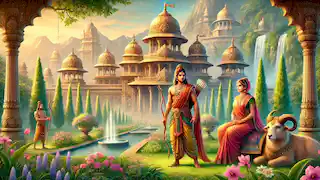
About Story: The Story of the Ramayana is a Myth from india set in the Ancient. This Dramatic tale explores themes of Good vs. Evil and is suitable for All Ages. It offers Cultural insights. The epic journey of Prince Rama to defeat Ravana and restore peace.
{{{_intro}}}
The Ramayana is a timeless epic from ancient India, composed by the sage Valmiki around the 5th century BCE. This story, deeply embedded in Indian culture and spirituality, revolves around Prince Rama, the seventh incarnation of the god Vishnu, and his journey to fulfill his destiny. Through Rama’s tale, the epic explores profound themes such as duty, righteousness, sacrifice, loyalty, and the eternal battle between good and evil. As we journey through this ancient story, we encounter not only battles and trials but also deep personal struggles, devotion, and moments of spiritual insight that transcend time. In the vast and prosperous kingdom of Ayodhya, there ruled a noble and revered king named Dasharatha. His kingdom thrived under his rule, a realm where peace and prosperity flourished. However, King Dasharatha was plagued by sorrow for he had no heir to continue his lineage. After many years of prayers and rituals, the gods finally blessed him with four sons from his three queens. The eldest and most virtuous was Rama, born to Queen Kausalya. Bharata was born to Queen Kaikeyi, while the twins Lakshmana and Shatrughna were born to Queen Sumitra. Among the four brothers, it was Rama who stood out as the embodiment of dharma (righteousness). His presence radiated compassion, courage, and wisdom. From an early age, he was taught the scriptures, archery, and the ways of a warrior, becoming a model of virtue for all of Ayodhya. His closest companion was Lakshmana, who adored his older brother and vowed to stand by him through thick and thin. Unbeknownst to King Dasharatha, Rama’s birth was not just the fulfillment of a father’s wish for an heir, but the manifestation of a divine plan. The world was plagued by the evil deeds of demons (rakshasas), particularly Ravana, the powerful king of Lanka, whose tyranny knew no bounds. Rama was destined to destroy this evil and restore balance to the universe. Rama’s early years were filled with teachings, princely duties, and the admiration of his subjects. His wisdom and grace earned him great respect not only in Ayodhya but in neighboring kingdoms as well. The defining moment of Rama’s youth came when he and Lakshmana were summoned by the sage Vishwamitra to protect his sacred yagna (ritual sacrifice) from the interference of demons. Rama and Lakshmana, without hesitation, agreed to accompany the sage and protect the ritual from evil forces. In the forest, Rama encountered the demoness Tataka, a fearsome creature with immense strength. In a display of his valor and skill, Rama defeated her, thus beginning his battle against the forces of darkness. Vishwamitra, impressed with Rama’s abilities, bestowed upon him powerful divine weapons that would aid him in future battles. After successfully completing his mission, Rama’s fame spread far and wide. His next great adventure came when the brothers traveled to the kingdom of Mithila, where a grand swayamvara (bridegroom selection ceremony) was being held for Princess Sita. Sita was renowned for her beauty, grace, and virtues, and many suitors had gathered to compete for her hand in marriage. However, the challenge set by King Janaka was no small feat – the suitor had to lift and string the mighty bow of Lord Shiva, an ancient and powerful weapon that none had ever been able to wield. Rama, with ease and humility, approached the bow. To the amazement of the gathered kings and princes, he not only lifted it but, in the process of stringing it, broke it in half. This act signified his divine strength and his right to marry Sita. Thus, Rama and Sita were united in marriage, a bond that symbolized the union of virtue and grace, divine will, and human love. Their marriage was celebrated with great joy and fanfare across Mithila and Ayodhya. For many years, King Dasharatha ruled Ayodhya in peace, and his sons brought great honor to the kingdom. As Dasharatha grew older, he decided it was time to appoint Rama as the crown prince. The people of Ayodhya rejoiced at this decision, as Rama was beloved by all for his wisdom, courage, and fairness. However, this decision sparked a chain of events that would change the course of Rama’s life. Kaikeyi, the youngest of Dasharatha’s queens and the mother of Bharata, was initially overjoyed at Rama’s coronation. However, under the influence of her cunning maid Manthara, she was reminded of the two boons that King Dasharatha had promised her years ago when she had saved his life in battle. Manthara, consumed with jealousy and greed, convinced Kaikeyi to demand that her son Bharata be crowned king and that Rama be exiled to the forest for fourteen years. With a heavy heart, Kaikeyi approached King Dasharatha and demanded the fulfillment of her boons. Dasharatha was devastated by her request, but bound by his word, he had no choice but to comply. When Rama heard of this, he accepted his fate with grace and humility. Despite the protests of the people of Ayodhya, Rama prepared to leave the kingdom, relinquishing all claims to the throne. Sita, ever devoted to her husband, refused to let him go alone. She insisted on joining him in exile, even though the forest was fraught with dangers and hardships. Lakshmana, too, could not bear the thought of his brother facing such trials alone and vowed to accompany them. With heavy hearts, the people of Ayodhya watched as Rama, Sita, and Lakshmana left the royal palace and ventured into the wilderness. Thus began their long exile, a period of trials, challenges, and profound growth. For the first few years of their exile, Rama, Sita, and Lakshmana lived a simple and peaceful life in the forest of Dandaka. They built a modest hut and spent their days in contemplation, meditation, and protecting the sages and hermits who lived in the forest from the threats of the rakshasas (demons). The forest, though wild and untamed, became their sanctuary. However, their peace was soon shattered by the arrival of Shurpanakha, the sister of Ravana, the powerful king of Lanka. Shurpanakha, wandering the forest, was captivated by Rama’s beauty and noble demeanor. She approached him with amorous intentions, unaware of his devotion to Sita. Rama, ever courteous, gently rejected her advances, explaining that he was already married. Enraged by his rejection and the insults she received from Lakshmana, Shurpanakha attacked Sita in a fit of jealousy. Lakshmana, in a swift move, cut off Shurpanakha’s nose and ears, leaving her humiliated and furious. Shurpanakha, seeking revenge, fled to her brothers Khara and Dushana, powerful demon warriors, and urged them to attack Rama and Lakshmana. A fierce battle ensued in the forest, with Rama and Lakshmana emerging victorious, slaying the demons with their divine weapons. This event set in motion a series of events that would lead to an even greater confrontation. Shurpanakha fled to Lanka and told her brother Ravana of the humiliation she had suffered. Ravana, a demon king with immense power and ambition, was intrigued not only by the insult to his sister but also by tales of Sita’s beauty. Determined to possess Sita and exact revenge on Rama, Ravana devised a cunning plan to abduct her. Ravana knew that a direct confrontation with Rama would be risky, as the prince was not only a skilled warrior but also divinely protected. Instead, Ravana sought the help of Maricha, a demon with the ability to shape-shift. Maricha, though initially reluctant, was forced by Ravana to take the form of a golden deer and lure Rama away from the safety of their hut. Sita, enchanted by the beauty of the golden deer, begged Rama to capture it for her. Though suspicious of the deer’s true nature, Rama agreed to pursue it for Sita’s sake. Before leaving, he instructed Lakshmana to stay behind and protect Sita. Rama chased the deer deep into the forest, and as he reached it, the deer revealed its true form and let out a cry mimicking Rama’s voice, calling for help. Sita, hearing the cry, feared for Rama’s safety and urged Lakshmana to go after him. Lakshmana, though hesitant, finally agreed, but not before drawing a protective line around their hut, warning Sita not to cross it under any circumstances. As soon as Lakshmana left, Ravana, disguised as a wandering ascetic, approached the hut. He begged Sita for alms, and when she stepped over the protective line to offer him food, Ravana revealed his true identity and kidnapped her, carrying her away to his kingdom in Lanka. When Rama and Lakshmana returned to the hut, they were devastated to find Sita missing. Despair turned to resolve, and the brothers set out on a perilous journey to rescue Sita, vowing to defeat Ravana and bring her back. #### The Search for Sita and the Alliance with the Vanaras Rama and Lakshmana’s quest to find Sita took them through dense forests, across rivers, and over mountains. Along the way, they encountered many beings, both benevolent and malevolent. One of their most faithful allies was Jatayu, an elderly bird who had witnessed Ravana abducting Sita. Jatayu had tried to stop Ravana but had been mortally wounded in the process. With his dying breath, Jatayu told Rama the direction in which Ravana had taken Sita, providing a crucial clue in their search. The brothers continued their journey, eventually reaching the kingdom of Kishkindha, ruled by the vanaras (monkey-like beings). There, they met Hanuman, the son of the wind god Vayu and the mightiest of the vanaras. Hanuman, upon learning of Rama’s plight, pledged his unwavering support. He introduced Rama to Sugriva, the exiled king of the vanaras, and a strong alliance was formed. With the help of Sugriva’s army, Rama intensified his search for Sita. Hanuman, with his immense strength and ability to leap across vast distances, eventually discovered Sita in the gardens of Ravana’s palace in Lanka. Despite being imprisoned, Sita remained steadfast in her devotion to Rama, refusing Ravana’s advances. Hanuman reassured her that Rama would soon come to rescue her and, after a series of daring feats, returned to Rama with the news of Sita’s whereabouts. With the knowledge of Sita’s location, Rama prepared for the final confrontation with Ravana. However, the island of Lanka lay across the ocean, an impassable barrier that separated them from their goal. Undeterred, Rama prayed to the ocean god for guidance. The ocean god, impressed by Rama’s devotion and righteousness, revealed the secret to crossing the sea – a bridge could be built by the vanaras using stones and trees. Hanuman and the vanaras, with their immense strength and determination, began constructing a massive bridge across the ocean. Through their collective effort, they completed the bridge in a short time, a marvel that allowed Rama’s army to march into Lanka and begin the great battle against Ravana’s forces. The war that followed was a monumental clash between the forces of good and evil. Ravana’s army of rakshasas, with their terrifying strength and magical powers, seemed invincible. But Rama’s army, composed of vanaras and led by the courageous Hanuman, fought valiantly. The battlefield was a chaotic scene of flying arrows, clashing swords, and supernatural weapons. Ravana unleashed his most powerful warriors, including his son Indrajit, a master of sorcery and deception. Indrajit’s mastery of illusion caused confusion and destruction among Rama’s forces, but Lakshmana, guided by his unwavering dedication to his brother, confronted and defeated Indrajit in a fierce battle. Hanuman, too, played a critical role in the war, using his superhuman abilities to leap across the battlefield, crushing demons and even retrieving the magical herb Sanjeevani from the Himalayas to heal the wounded Lakshmana when he was gravely injured in battle. The final confrontation between Rama and Ravana was a duel of epic proportions. Ravana, with his ten heads and twenty arms, wielded terrifying weapons, but Rama, empowered by his divine mission, fought with unmatched skill and determination. In a final act of divine intervention, Rama unleashed the Brahmastra, a celestial weapon given to him by the gods, striking Ravana down and ending his reign of terror. With Ravana’s death, the world was freed from his tyranny, and the forces of darkness were vanquished. The gods rejoiced, and peace was restored. After the defeat of Ravana, Rama rescued Sita, but their reunion was clouded by doubts. Although Rama had fought tirelessly to save her, he was tormented by the thought of whether Sita had remained pure during her captivity in Ravana’s palace. The whispers of suspicion grew, and Rama, bound by his duty to uphold the moral standards of his kingdom, questioned her chastity. Heartbroken by her husband’s doubts, Sita resolved to prove her purity in the ultimate test – the Agni Pariksha, or trial by fire. Sita declared that if she had remained faithful and pure, the flames would not harm her. She entered the fire, and to the amazement of all, the god Agni himself emerged from the flames, carrying Sita unharmed. This miraculous event affirmed her innocence, and Rama, filled with remorse, welcomed her back with open arms. Their journey, though fraught with trials, had come to a close. They returned to Ayodhya, where the people awaited them with great joy. Upon their return to Ayodhya, Rama was crowned king, and Sita took her rightful place as queen. The coronation was a grand affair, with the entire kingdom celebrating the return of their beloved prince. Rama’s reign, known as Rama Rajya, became the epitome of good governance, justice, and prosperity. Under his rule, the land flourished, and peace prevailed. However, even as the kingdom prospered, rumors and doubts about Sita’s time in Lanka continued to circulate among the people. Unable to bear the weight of public suspicion, Rama made the painful decision to exile Sita, who was pregnant with their twin sons. Though devastated, Sita accepted her fate and sought refuge in the hermitage of the sage Valmiki. In the forest, Sita gave birth to Lava and Kusha, who grew up to be valiant and noble warriors. Years later, the twins unknowingly confronted their father during a grand festival in Ayodhya, where they recited the story of Rama’s life, as taught to them by Valmiki. It was through their valor and the verses of the Ramayana that Rama realized they were his sons. Sita, however, heartbroken by her long separation from Rama and the hardships she had endured, prayed to Mother Earth to take her back. The earth opened up, and Sita was embraced by her mother, leaving Rama to rule Ayodhya alone. The Ramayana is more than just a story; it is a guide to living a life of virtue, duty, and righteousness. The characters, with their strengths and flaws, represent the complexities of human nature and the eternal struggle between good and evil. Rama, the ideal man, shows us the importance of upholding dharma, even in the face of immense personal loss. Sita, through her devotion and resilience, teaches us the power of love and loyalty. Lakshmana’s unwavering support for his brother is a testament to the strength of family bonds, while Hanuman’s devotion exemplifies the highest form of selfless service. Even today, the Ramayana continues to inspire and guide millions of people across the world. Its lessons are timeless, reminding us of the importance of duty, sacrifice, and the pursuit of righteousness in our own lives.Introduction to the World of the Ramayana
Rama’s Youth and the Marriage of Sita
The Exile of Rama
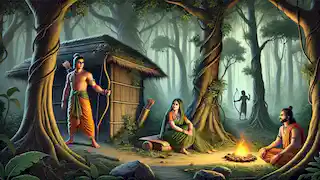
The Forest of Dandaka and the Arrival of Shurpanakha
The Abduction of Sita
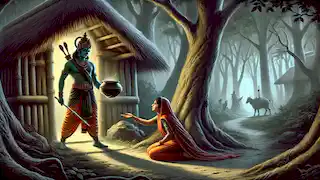
The Building of the Bridge to Lanka
The Great Battle at Lanka
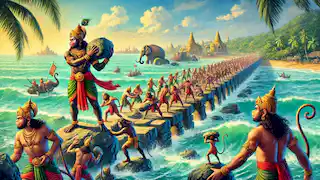
Sita’s Ordeal by Fire
Rama’s Coronation and Reign as King
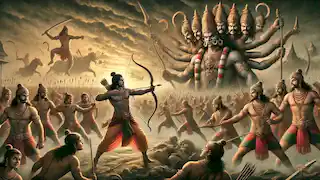
The Legacy of the Ramayana

















